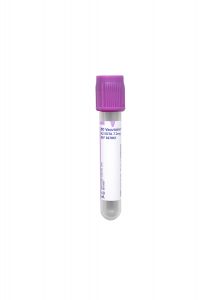Test Name
CPT Codes
81219
G0452
Methodology
Polymerase Chain Reaction with fragment length analysis by capillary electrophoresis
Turnaround Time
7 days
Specimen Requirements
Type:
Aspirate, bone marrow
Volume:
2 mL
Minimum Volume:
1 mL
Specimen Container:
Lavender BD Hemogard™ K2EDTA Tube

or:
Type:
Formalin-fixed paraffin-embedded tissue/bone marrow clot
Volume:
1 block
Transport Temperature:
Ambient
or:
Type:
Blood, whole
Volume:
4 mL
Minimum Volume:
2 mL
Specimen Container:
Lavender BD Hemogard™ K2EDTA Tube

Stability
Ambient:
48 hours
Refrigerated:
7 days
Frozen:
Unacceptable
Formalin-fixed paraffin-embedded tissue/bone marrow clot:
Indefinitely
Additional Information
Background Information
The BCR/ABL1-negative myeloproliferative neoplasms (MPN) include polycythemia vera (PV), essential thrombocythemia (ET), and primary myelofibrosis (PMF).1 The JAK2 V617F point mutation occurs in >95% of cases of PV and approximately 50-60% of cases of ET and PMF. In ET and PMF lacking the JAK2 V617F mutation, approximately 10-20% contain a mutation in MPL exon 10 while 60-80% of cases have a mutation in CALR.2,3
The identification of a JAK2, MPL, or CALR mutation is diagnostically useful to separate MPN from a reactive leukocytosis that may mimic a myeloid neoplasm. Cases of ET and PMF with mutations of JAK2, MPL, or CALR may also show prognostic differences.4–7
Approximately 80% of CALR mutations can be classified as either type 1 (a 52-bp deletion) or type 2 (a 5-bp insertion). The remaining mutations represent other, variably sized insertions and deletions. All CALR mutations (type 1, type 2 or other) create a frameshift with the production of an altered C-terminus of the calreticulin protein.
Cleveland Clinic Laboratories has developed, validated and implemented a sensitive PCR assay for the detection of CALR mutations in peripheral blood, bone marrow or formalin-fixed, paraffin-embedded tissues.
Clinical Indications
CALR mutation testing is useful in the workup of suspected myeloproliferative neoplasms, especially those that are negative for JAK2 V617F.
Interpretation
Normal results are reported as “CALR mutation not detected.”
Positive results are reported as “CALR mutation detected,” and an interpretation is provided that includes a description of the mutation (type 1, type 2, or other).
Methodology
Genomic DNA is extracted from the sample and CALR exon 9 is amplified by PCR. Fragment length analysis is performed to assess for insertion/deletion mutations.
Limitations
This assay has a sensitivity of 5% mutant alleles. This assay detects only insertion/deletion mutations in CALR exon 9, and a negative result does not exclude the possibility of a myeloproliferative neoplasm.
References
1. Swerdlow SH, Campo E, Harris NL, et al. WHO Classification of Tumours of Haematopoietic and Lymphoid Tissues. Lyon: IARC Press; 2008.
2. Nangalia J, Massie CE, Baxter EJ, et al. Somatic CALR mutations in myeloproliferative neoplasms with nonmutated JAK2. N Engl J Med. 2013;369:2391-405.
3. Klampfl T, Gisslinger H, Harutyunyan AS, et al. Somatic mutations of calreticulin in myeloproliferative neoplasms. N Engl J Med. 2013;369:2379-90.
4. Tefferi A, Lasho TL, Finke CM, et al. CALR vs JAK2 vs MPL-mutated or triple-negative myelofibrosis: clinical, cytogenetic and molecular comparisons. Leukemia. 2014;28:1472-7.
5. Tefferi A, Wassie EA, Lasho TL, et al. Calreticulin mutations and long-term survival in essential thrombocythemia. Leukemia. 2014;28:2300-3.
6. Rumi E, Pietra D, Pascutto C, et al. Clinical effect of driver mutations of JAK2, CALR, or MPL in primary myelofibrosis. Blood. 2014;124:1062-9.
7. Rumi E, Pietra D, Ferretti V, et al. JAK2 or CALR mutation status defines subtypes of essential thrombocythemia with substantially different clinical course and outcomes. Blood. 2013;123:1544-1551.
